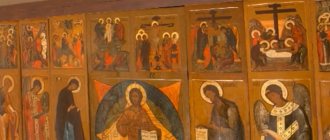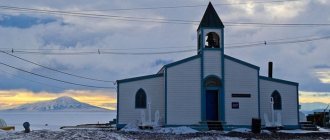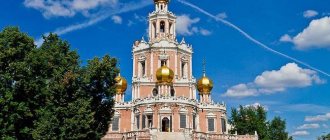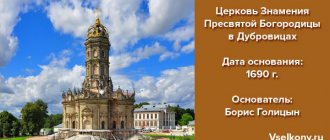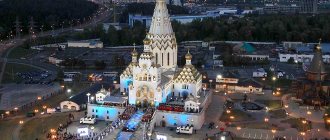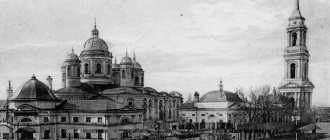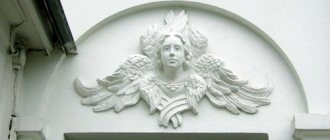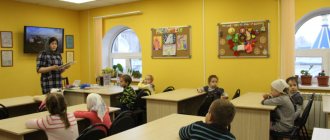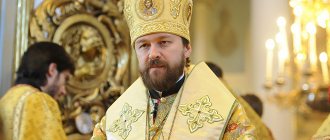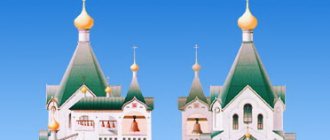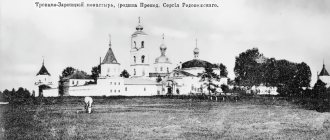The Christian heritage of the Russian people is very great. Various objects of cultural heritage surprise with their unique beauty and grandeur, which have survived to this day and personify the essence of the Christian faith. Most of these historical monuments are located in the capital of the country and in its suburbs.
Among all the Christian heritage, the Tsaritsyno estate attracts special attention. On its territory there is the most beautiful park in the world combined with a magnificent palace and temple.
The church in Tsaritsyno emphasizes the predisposition to faith of those who created this picturesque world, surprising future generations with its architectural decoration.
Historical background
The Tsaritsynsky inheritance is the territory of a former rich boyar estate, which includes a wide variety of agricultural production facilities. The main symbol, of course, of the stable development of the estate was the church, the parishioners of which were the owners of the estate themselves and everyone who worked within its boundaries.
The Church of God in Tsaritsino was initially built of wood. The idea of construction belongs to the Streshnev boyars, the first owners of the estate. The first building had five domes and a beautiful painted wooden belfry.
The second owner of the estate was the politician Cantemir, who decided that the wooden structure did not look so majestic and ordered the construction of a stone temple (1722). However, the constructed building was not as picturesque as the owner of the property wanted, and in 1759-1765. it was completely rebuilt. To this day, the name of the person who created the unique design of the beautiful temple is not known. The idea of the owner of the estate was implemented as expected.
However, the third owner of the estate, Catherine II, having bought the estate in 1775, decided to build a majestic palace on its territory, she completed the church in her own way, and the architect Lavin worked at the queen’s request to finalize the project. Under his strict leadership, the building was brought to perfection.
The Church of God in Tsaritsyno has a majestic appearance, built in the very center and attracts attention with its special architectural beauty. The erected wooden church and the later built stone temple were dedicated to such a Christian relic as the icon of the Mother of God “Life-Giving Source”.
In the thirties of Soviet power, this Christian initiative was not easy. It was forbidden to hold religious services in the building, and its walls were used as a transformer substation, and later as a printing house.
In 1990, the Church of God in Tsaritsino was transferred to the control of believers and today is a functioning Orthodox church.
Temple in Tsaritsyno, within Moscow
The building of 1722 was erected to replace the wooden church of the Streshnev boyars, who previously owned the estate. During the construction of the palace, Bazhenov preserved the temple in Tsaritsyno, then it went through several reconstructions and additions, the last one was carried out by the architect Lavin. The church was closed only in 1939 and was used to house an electrical transformer. In the 70s of the last century there was a printing house there, then a carpentry workshop. The church in Tsaritsino was returned to the Russian Orthodox Church in 1990; the absence of serious damage made it possible to soon consecrate the church and resume services.
A photograph from the northeast gives an idea of the architectural appearance of the temple in Tsaritsyno today. The tetrahedral shape of the altar apse is not quite common; usually the outlines are smooth. Otherwise, everything is traditional - a quadruple base, with an octagonal central volume on it. Next is a rectangular refectory and a bell tower, made at the same time as the entire temple.
The traditional government protection warning sign provides some information about the church's founder. It is worth saying that the scientific works of Dmitry Cantemir had a historical and philosophical orientation and concerned Moldova and the Ottoman Empire. He also wrote the first historical novel in the Moldavian language. There were significantly more political events and titles in Cantemir’s life.
Being the son of the ruler (sovereign) of Moldova, he himself was confirmed in office by the Turkish Sultan with delays and delays. Contrary to the condition set by the Sultan to prepare for war with Russia, he entered into an alliance with Peter the Great, participated in the Prut campaign, and then lived in Russia. Kantemir - the elder was an imperial adviser and comrade-in-arms, received the title of His Serene Highness, and was a senator with the rank of Privy Councilor.
Perfect temple architecture
In terms of the beauty of so many cultural treasures, including the original church in Tsaritsyno, Moscow ranks first in the world. The presence of the most expensive and magnificent historical heritage of the Christian movement shows how developed the spiritual community of the people was.
The temple was built in the Elizabethan Baroque style, which is characterized by octagonal domes topped with tetrahedral additions. On the facades there are double pilasters, volutes, window casings are framed in white.
Russian Orthodox ChurchFinancial and economic management
Object of cultural heritage of federal significance “Ensemble of the Tsaritsyno estate, 18th century. Church (Temple of the Icon of the Mother of God “Life-Giving Source”)”
Address: st. Dolskaya, 2, building 1
Rector: Archpriest Oleg Korytko
Contractor: STG-group LLC (2019-2018)
Technical supervision: NP "Unified Customer Service of the Moscow Patriarchate" (2019 and 2018)
Author's supervision: STG-group LLC (2019) Author's supervision: ArtResStroy LLC (2018)
Temple website: spring-life.ru
RESTORATION
In 2021, restoration work was financed under the Subsidy Program from the Moscow city budget. The following work was carried out: restoration of the brickwork of the facades of the quadrangle and the refectory part of the temple , including elements of white stone decor and the plinth, porch and basement, reconstruction of windows and doors, repair of roof structures and coverings, including protruding parts, restoration of the temple's completions.
In 2021, as part of the Program for Providing Subsidies from the Moscow City Budget, the bell tower of the temple . Work was carried out on the restoration of facades, a white stone plinth, repair of roof structures and coverings, restoration of completions (dome, cross), reconstruction of window and door carpentry, installation of cut-off waterproofing and blind areas.
AllTemple of the Icon of the Mother of God “Life-Giving Spring” in Tsaritsyn
Story
The temple is located on the territory of the Tsaritsyno Museum-Reserve.
The church in Tsaritsyn, located on the territory of the palace and park ensemble of the late 18th century, was built long before the construction of the palace as the parish church of the “Blessed Virgin Mary of the Life-Giving Spring.”
It is known that in 1633 the Black Mud estate was acquired by boyar A.S. Streshnev, and in 1680 it was inherited by his grandson Prince A.S. Golitsyn, under whom the estate was superbly equipped and an extensive farm was established.
The Streshnev boyars built a wooden church, about which in the inventory books of the Golitsyn princes it is said: “... about five chapters, covered with scales of greenery, painted with three colors, .. in front of the church there is a chopped wooden bell tower, painted with different paints.”
In 1689, with the fall of Princess Sophia, her favorite Prince Vasily Golitsyn fell into disgrace, and with him his son and grandson A.S. Streshnevs. Golitsyn, and their estates were taken to the treasury “for their guilt.”
In 1713, the estate “Black Mud” was donated by Peter I to the Moldavian ruler Dmitry Konstantinovich Cantemir “for special services to the fatherland” in the fight against the Turks, the same famous Cantemir, whose three hundredth anniversary was celebrated by UNESCO in 1973, an outstanding linguist, philosopher, an architect, archaeologist, musician and mathematician who knew several languages, incl. Turkish and Persian, and who managed the office of Peter I during the Persian campaign.
In 1722, Cantemir built a stone church in the Petrine Baroque style on the site of a wooden church. In 1759-1765 the church was rebuilt by his son and heir M.D. Kantemir. The temple served as the tomb of the family. In 1771, on November 30, Prince M. D. Cantemir was buried here, and later his wife Princess A. Ya. Cantemir.
In 1775, Catherine II bought the Black Dirt estate from the Kantemirovs and renamed it the village of Tsaritsyno. The Empress commissioned the architect V.I. Bazhenov to draw up and implement a project for her country residence on the purchased estate. When drawing up the design of the palace complex, Bazhenov retained the Cantemir Church as an element in the ensemble of estate buildings.
At the end of the 19th century. The church was again rebuilt with the money of A.I. Klementovich, the owner of one of the dachas located in Tsaritsyn, as well as with public funds collected for this purpose. The refectory was expanded, for which it actually had to be rebuilt, a chapel in the name of the Kazan Icon of the Mother of God was added, and the bell tower was moved and increased in height (up to four tiers).
The church operated as a parish until 1939, when it was closed for non-payment of debts. After closing, the church building was converted into a transformer booth in the 1970s. - for a printing house, and from 1975 to 1990. it housed the carpentry workshop SNRM-3 at the Union of Soyuzrestavratsiya, with heavy woodworking machines, the work of which damaged both the building itself (cracks appeared in the walls and domes) and the wall paintings of the temple.
In 1990, the Church of the Mother of God Life-Giving Spring was transferred to the use of the community of believers, Archpriest Georgy Breev was appointed rector, and services resumed on October 6.
According to the inventory of the village of Tsaritsyno and from the recollections of old parishioners of the temple, it is known that there were two wooden houses near the church in which the priests lived. One of them, located very close to the church, was demolished by carpentry workers and a brick house was built on its foundation, now transferred to the use of the Church.
Religious organization "Church of God" in Tsaritsyno
In modern times, the church operates a Christian library, a Sunday school for supporting prisoners, an Orthodox bookstore, and a Christian pilgrimage center.
The most worthy activity of the temple is the religious organization “Church of God” in Tsaritsyno (Moscow), which is engaged in charitable activities and organizing preaching events for Christians of the evangelical faith.
The return of the temple to its direct purpose led to the restoration and restoration of the building, which is being carried out gradually at the expense of the accumulated funds of parishioners as donations.
Of course, such centuries-old beauty should serve the people as a visual reminder of faith in God and worship of him, which is why today all efforts are aimed at recreating the historical roots of many Christian objects in the Russian country. Rethinking Christian values leads to good deeds that help restore old splendor and create new ones.
External appearance of the temple in Tsaritsino
The bell tower, which also serves as the entrance to the temple in Tsaritsino, consists of four tiers of decreasing height. Above the entrance is a mosaic image of the Virgin and Child, and next to the doors is a previously seen sign. The second tier with ordinary glazing is the abode of bell ringers; the belfry occupies the two upper tiers.
The highest third tier is intended for the largest bells; the area of the openings there is the largest. The opening is outlined by a large arch, inside of which there are two narrow ones, converging in the middle into a single opening. On the fourth tier there is no external arch, the opening and bells are smaller. On the hipped roof there is a light drum with a relatively small dome.
The summer surroundings surrounding the temple in Tsaritsino are very picturesque and well-groomed. Evenly trimmed lawn grass is separated by curbs from neat walking paths. There are many trees around the building, especially a giant larch, clearly of considerable age, that stands out. People in the church fence move slowly and respectably, only restless children can run around and lie on the grass.
A winter view from almost the same point shows the greatly changed appearance of the temple in Tsaritsyno. The trunks and branches of the trees that have lost their leaves have become almost invisible; the larch that has lost its needles does not look like a summer larch. The few passers-by are dressed very differently, the Christmas slogan on the fence reminds of the already obvious time of year.
But in winter, nothing prevents you from examining the appearance and design features that characterize the temple in Tsaritsyno. The method chosen by the builders to highlight significant elements of the building is striking. The pilasters and window casings, as well as some other details of the structure, are painted white.
Like all Russian nature, the surroundings of the church have their charms in any season of the year, and every weather is good.
All the more indifferent is seasonality when applied to a spiritual refuge, if only true faith leads there, and not habit or pretense. Tags: MoscowRussiaestate-museumtempleTsaritsino
